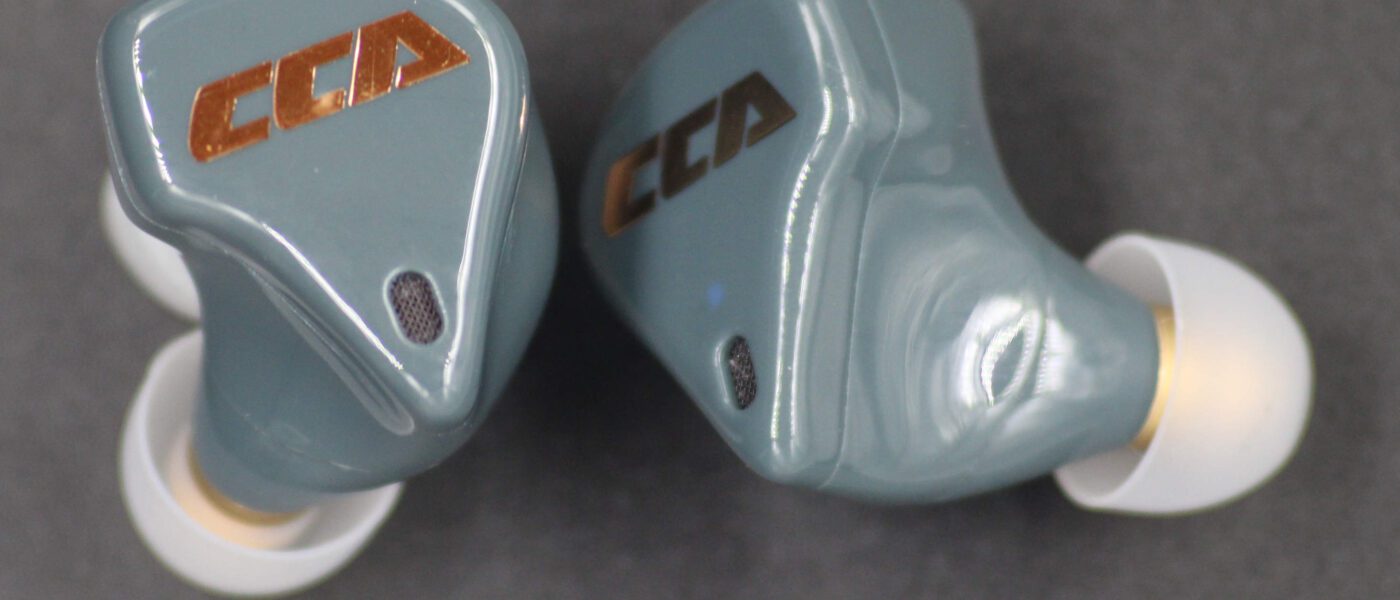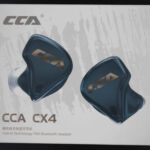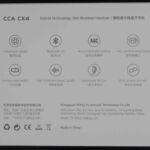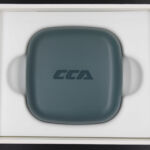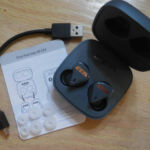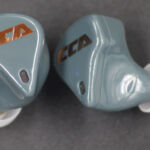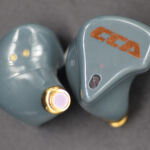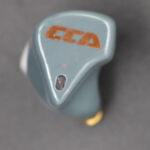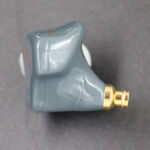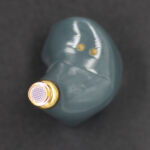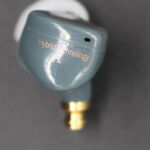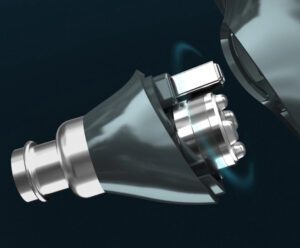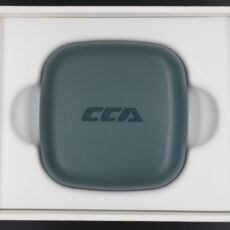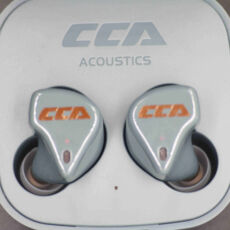CCA CX4
disclaimer: The CCA CX4 and CX10 were provided for purposes of review by Better Audio. I have no financial interest in CCA, KZ, or Better Audio and have not received any compensation for this review. If you have an interest in the CX4 you can get more information from the Better Audio’s store on Amazon.
Unboxing / Packaging:
The CX4 comes shipped in a lift top style box with the CCA logo, model name and rendering of the earpieces on the top and specs on the bottom in English, Chinese, and Pictogram format. Lifting the top reveals the case in a plastic tray with the charging cable and additional tips hiding underneath. 3 sets of silicone tips in small, medium, and large are provided. The kit is fairly small, but for a budget TWS, it has everything you need right out of the box. Worth noting, charging is handled by the older Micro-USB standard rather than the newer USB-C.
Build/Fit:
Shells are a multi-part design with the bulk being resin bonded to a brass nozzle. The shell is comprised of a 4 major parts, a faceplate, main body (the bulk of the inner shell), an inner resin plate that attaches the nozzle, and the brass nozzle itself. Seems are well fitted but very visible and detract from the semi-custom shape of the earpieces. The Earpieces have 2 vents, one at the lower edge of the faceplate (a vertical oblong arrangement) and the other much smaller at the top edge along the junction of the faceplate and main body near where the model name is printed. The inner surface has a pair of charging pads that are slightly counter sunk in the resin to avoid contact with the ear. Nozzles have a distinct forward rake and a pronounced lip for tip retention. Insertion depth is fairly deep, but isolation is only average due to the size and venting.
Internals / Bluetooth:
The CX4 uses a 7mm dual magnet dynamic driver for the lows and mids and a single 30019 armature for the highs. Sensitivity is listed as 93dB/mW but no impedance is listed. I searched a good bit looking for what bluetooth chip was in use but was unable to find a definitive answer. It does support Bluetooth 5.0 but is limited to SBC and AAC with no support for AptX HD or LDAC which is a little disappointing considering the competition increasingly supports these protocols. The battery in each earpiece is listed as a 40mA lithium ion cell and my testing showed actual capacity to be roughly that as well. I found Bluetooth range to be good in open space, but easily defeated by walls (even cubicle walls). With AAC on, the CX4 had solid connectivity but in SBC mode cut-outs were fairly common. Gaming mode introduces a lower latency but connectivity was roughly between AAC and SBC and not being a big gamer, I didn’t really test it fully.
Case/Battery:
The case is a plastic clamshell design with CCA cast into the lid and a single micro-USB port on the right hand side. Inside the case there is a single LED indicator between the recesses for the two earpieces. The case itself houses a 400mAh lithium ion battery and charge circuitry. The LED lights red while charging and green when full charge is reached. During the charging process, if when disconnected the LED is red the case is between 0-30% charged, if yellow 30-70% and green = above 70%. It would be nice to have some indicator on the shell’s exterior for this as you have to open the case to see the charge state. I found battery life of the earpieces to be roughly 2.5 hours depending on listening volume.
Function/Controls:
When using the CX4, you have to take both earpieces out of the case at roughly the same time or it will connect in mono mode as they can be used as a single earpiece for phone conversations if desired. They have the familiar red/blue blink when pairing and then go to red /blue alternating on master (slower blink) and flashing blue on slave when paired. There is also an audible prompt for pairing and paired as well.
To turn them on or off when outside the case, touch and hold the face of each earpiece. 3 seconds should be enough to turn them on but to turn them off takes 6 seconds of constant contact with the face. Also if placed back into the case, the units will automatically power off and charge then power on when removed from the case.
Similarly quick taps of the face can be used to control playback during use. A single tap is play/pause or can be used to answer/hang-up calls. if you touch and hold the face plate the call is rejected or if no call is present and your device suports it, a press and hold will activate Siri. Two quick taps to the left is previous, two taps to the right is next. Three quick taps to the earpiece enters low latency mode for games or movie watching.
Sound:
I didn’t end up doing the normal FR chart here as I had problems getting the CX4 to behave wheile trying to do so as it consistently only gave 50% effort so I ended up with a disjointed mess instead of a normal looking FR. Not sure what the issue is as I tried my normal test setup and also tried with the Hiby R3 pro as a usb DAC from the test laptop as the middle man and got the same results both times. I threw a couple other TWS models at the test system to be sure and those all worked as expected. I think the issue is inherent to the chipset in the CX4 rather than with the measurement rigs as I also saw the same problem with its sibling the CX10 that uses the same chipset.
Bass:
Sub-bass is emphasized and has good depth and rumble, but can get a little loose at times. Mid-bass is also emphasized with good slam, but here again a bit looser than it should be with more than a little bleed into the mids and some obstruction of detail due to the lack of control. Overall maybe better for movie or gaming than for audiophile listening as bass textures leave me wanting.
Mids:
The CX4 is a V-signature for sure, but a shallow one as mids are well present in the mix and other than some obstruction from bleed, fairly well voiced. Textures are better here with more detail represented and vocals have good weight. Female vocals are a step forward of male, but both still cut through well enough to be heard over the other instrumentation. Guitar growl is acceptable but not quite as crisp on the edges as it should be. Strings are a bit of let down as tonality is not quite where it should be and they lack a bit of life as a result.
Treble:
Lower treble is somewhat emphasized but is a step less so than the bass emphasis which keeps the CX4 from getting overly fatiguing. Treble shares the emphasis before falling back above about 8kHz with top-end extension being moderate. Snare rattle lacks a touch of sharpness and cymbals are not quite energetic enough to be lifelike, but come close. The CX4 shows that CCA is tuning down the top-end that KZ is none for a bit and going with a more relaxed top-end that is a bit more polite. The CX4 is still a bit bright but comes a lot closer to balanced than KZ usually does and the fatigue associated with some KZ/CCA models is not a likelihood here. The only drawback is it sacrifices a touch of detail for that smoothness.
Soundstage / Imaging:
Stage is wider than deep by a good margin and feels more like watching a movie at home or maybe a piano bar than a larger venue. Height is limited as well so instruments spread out wide and shallow on stage and seating the orchestra is a bit off due to positions being side by side instead of front to back at times. Instrument separation is about average but the CX4 does show a tendency to get a little murky on fast tracks with lots of lows and compression is evident at times. Imaging is reasonably good with some small inconsistencies with movement around the middle of the stage.
Thoughts / Conclusion:
Arguably the CX4 is the CCA version of the KZ S2. Both use the 7mm driver but the KZ version uses the 30095 instead of the 30019 for the top end. Both are in the $25 range so about as cheap as one can reasonably expect to find a working wireless in-ear. I do think the tuning is better on the CX4 as the highs are toned down a bit compared to the S2. Keeping the price tag in mind, I can forgive a fair amount and find the CX4 a bit better value than its bigger brother the CX10. They share shells, batteries, runtime, and have similar tunings. The CX10 has a bit more detail and a deeper stage but at double the price, I’m not sure that’s enough to make it a better choice. These aren’t high end audiophile in-ears, they are commodity, pair it with your phone for use at the gym, mowing the lawn, or on that high school trip. For purposes like those, the CX4 serves well and won’t break the bank if you lose one or break one.
-
Bass - 6.5/106.5/10
-
Mids - 6/106/10
-
Treble - 6.5/106.5/10
-
Soundstage - 5/105/10
-
Imaging - 6/106/10
Summary

